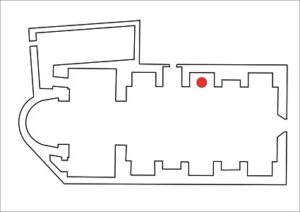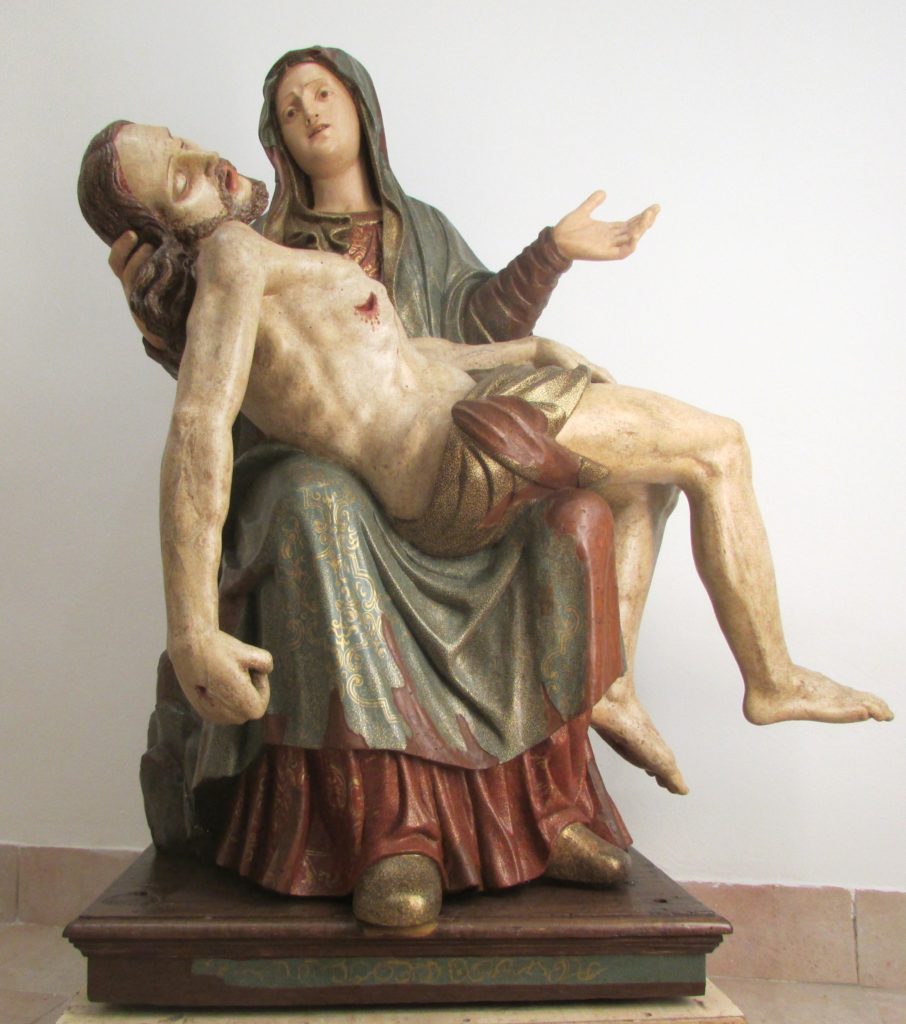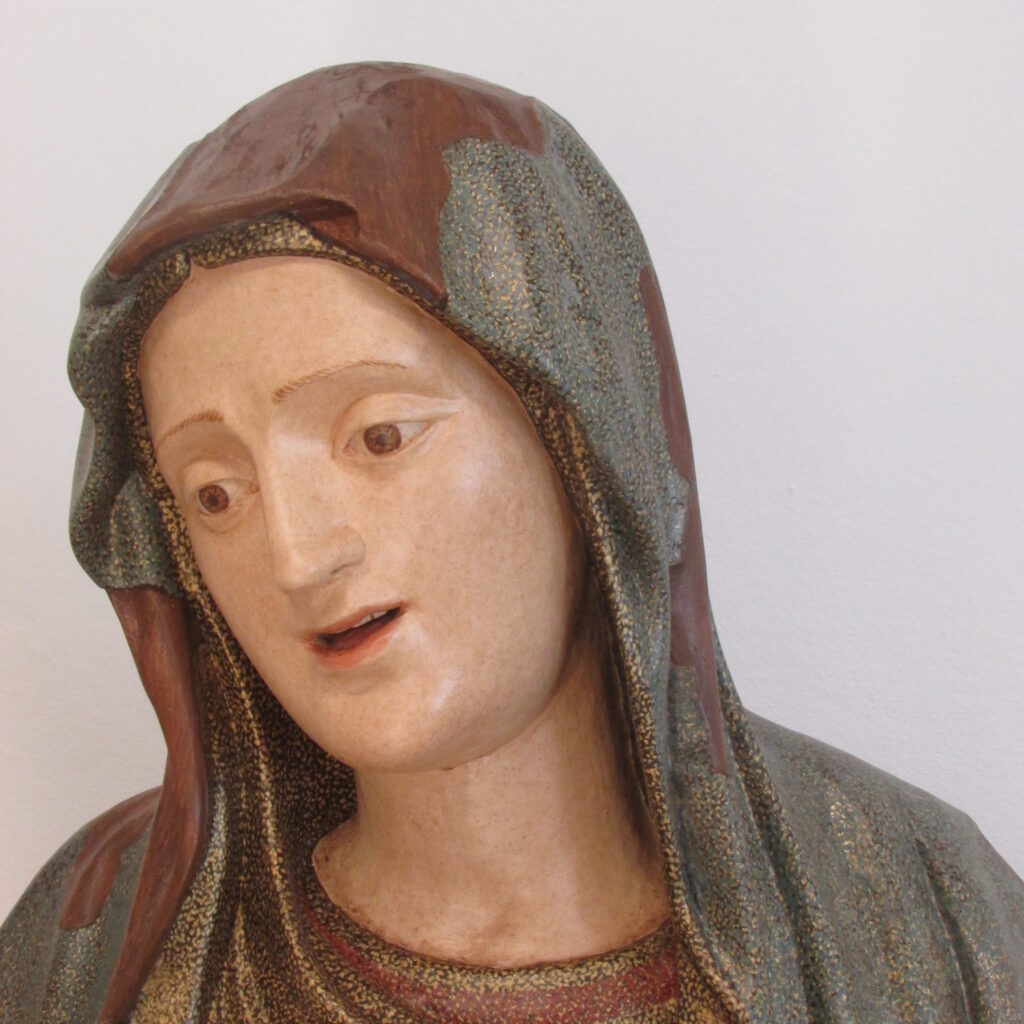La Pietà


Chiesa di S. Maria Maggiore
Scultura
La Pietà
Sec. XVI (prima metà)
Legno scolpito e dipinto
Ambito culturale napoletano

Church of S. Maria Maggiore
Sculpture
The Pity
16th century (first half)
Carved and painted wood
Neapolitan cultural sphere
Secondo la tradizione, non suffragata da documenti, l’opera sarebbe stata commissionata per la Chiesa di San Tommaso d’Aquino da Ladislao II d’Aquino, Marchese di Corato e Barone di Grottaminarda, vissuto tra la fine del XV secolo e la prima metà del XVI secolo. Nel primo documento noto, del 1698, che attesta la presenza dell’opera a Grottaminarda, risulta che la statua faceva parte di un gruppo scultoreo che comprendeva anche le statue di San Tommaso e di San Giacomo. Il gruppo di deposizione venne disperso tra la fine dell’Ottocento e l’inizio del Novecento.
According to tradition, not supported by documents, the work was commissioned for the Church of San Tommaso d’Aquino by Ladislao II d’Aquino, Marquis of Corato and Baron of Grottaminarda, who lived between the end of the fifteenth century and the first half of 16th century. In the first known document, from 1698, which attests to the presence of the work in Grottaminarda, it appears that the statue was part of a sculptural group that also included the statues of San Tommaso and San Giacomo. The deposition group was dispersed between the late nineteenth and early twentieth centuries.


Originariamente l’opera non fu concepita come statua per processione, ma dopo un restauro avvenuto nel XVII secolo, fu riadattata come statua processionale. Si tramanda che la statua veniva impiegata durante i riti della settimana Santa, principalmente durante la pia pratica delle “tre ore di agonia” del Venerdì Santo.
La scultura, per cifra stilistica, va datata alla prima metà del XVI secolo. L’ultimo restauro ha evidenziato un precedente e importante intervento ascrivibile alla prima metà del XVII secolo, che può essere messo in relazione alla ricostruzione della Chiesa di San Tommaso d’Aquino del 1636.
L’opera, come ha dimostrato l’ultimo restauro, era stata scolpita in un solo pezzo di legno di pioppo, o meglio da due alberi di pioppo che nel corso della loro vita si erano fusi insieme formando un unico albero ma con un doppio midollo.
L’anonimo artista della Pietà grottese conosceva le innovazioni artistiche introdotte da Michelangelo nella scultura, anche se l’impostazione è ancora legata alla cultura tardogotica e cortese meridionale. La Madonna raffigurata giovane con lo sguardo pacato e rassegnato, il riccio di stoffa sul petto, la mano sinistra aperta e rivolta verso l’alto, l’abbandono del corpo e la perfezione anatomica del Cristo, sono chiari riferimenti alle Pietà eseguite da Michelangelo; mentre la rigidità di Maria e del busto del Cristo sono invece il segno, ancora forte ed evidente, della cultura tardogotica e cortese.
La scultura è stata restaurata più volte nel corso dei secoli: una prima volta nel XVII secolo, poi ha subito vari interventi tra il XVIII secolo e il XX secolo. L’ultimo lavoro di restauro risale agli anni 2017-2018 ed è stato operato da Luigi La Bella, di Bologna, che ha riportato l’opera agli antichi
splendori.
Originally the work was not conceived as a procession statue, but after a restoration that took place in the seventeenth century, it was adapted as a processional statue. It is said that the statue was used during the Holy Week rites, mainly during the pious practice of the “three hours of agony” on Good Friday.
The sculpture, for stylistic figure, goes dated to the first half of the XVI century. The latest restoration has highlighted a previous and important intervention attributable to the first half of the seventeenth century, which can be related to the reconstruction of the Church of San Tommaso d’Aquino in 1636.
The work, as demonstrated by the last restoration, had been carved in a single piece of poplar wood, or rather by two poplar trees that in the course of their life had merged together forming a single tree but with a double marrow.
The anonymous artist of the Grottese Pity knew the artistic innovations introduced by Michelangelo in sculpture, even if the setting is still linked to the late Gothic and courtly southern culture. The Madonna depicted young with a calm and resigned gaze, the hedgehog on the breast, the left hand open and facing upwards, the abandonment of the body and the anatomical perfection of Christ, are clear references to the Pietà performed by Michelangelo; while the rigidity of Mary and the bust of Christ are instead the sign, still strong and evident, of the late Gothic and courteous culture.
The sculpture has been restored several times over the centuries: a first time in the 17th century, then it underwent various interventions between the 18th century and the 20th century. The last restoration work dates back to the years 2017-2018 and was carried out by Luigi La Bella, from Bologna, who restored the work to its former glory.



